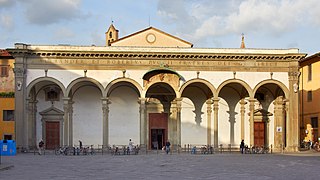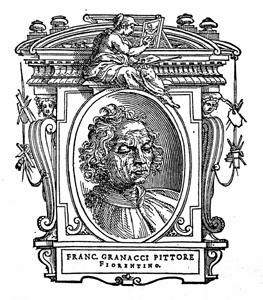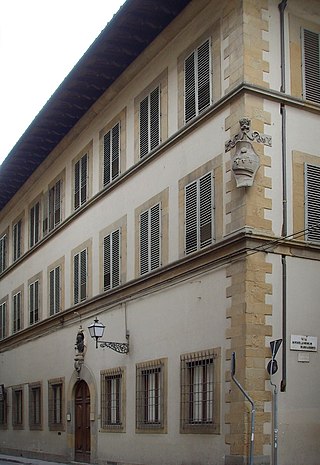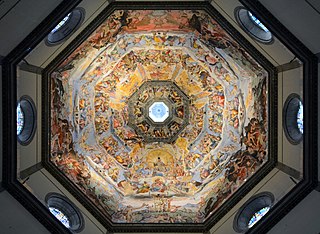Borsook, Eve (1960). The mural painters of Tuscany, from Cimabue to Andrea del Sarto. With 120 illus. London: Phaidon Press. OCLC 973461045. Archived from the original on 8 October 2020. Retrieved 8 October 2020.
{{cite book}}: CS1 maint: location missing publisher (link){{cite book}}: CS1 maint: location missing publisher (link){{cite book}}: CS1 maint: location missing publisher (link){{cite book}}: CS1 maint: location missing publisher (link){{cite book}}: CS1 maint: location missing publisher (link){{cite book}}: CS1 maint: location missing publisher (link){{cite book}}: CS1 maint: location missing publisher (link){{cite book}}: CS1 maint: location missing publisher (link)Selected articles
- Borsook, Eve (1954). "Documents concerning the Artistic Associates of Santa Maria della Scala in Rome". Burlington Magazine: 270–275. ISSN 0007-6287. OCLC 888561975. Archived from the original on 25 July 2020. Retrieved 8 October 2020.
- Borsook, Eve (1956). "The frescoes at San Leonardo al Lago". Burlington Magazine. 981956: 351–358. ISSN 0007-6287. OCLC 887178916. Archived from the original on 8 October 2020. Retrieved 8 October 2020.
- Borsook, Eve (1961). "A note on Masaccio in Pisa". Burlington Magazine: 212–215. ISSN 0007-6287. OCLC 888561949. Archived from the original on 25 July 2020. Retrieved 8 October 2020.
- Borsook, Eve (1969). "The Great Age of Fresco". Burlmaga the Burlington Magazine. 111 (794): 303–304. ISSN 0007-6287. OCLC 5548479177.
- Borsook, Eve (1969). "Addendum to the funeral of Philip II". Mitteilungen des Kunsthistorischen Institutes in Florenz / HRSG.: Kunsthistorisches Institut in Florenz, Max-Planck-Institut.: 247–250. ISSN 0342-1201. OCLC 886750694. Archived from the original on 25 July 2020. Retrieved 8 October 2020.
- Borsook, Eve (1975). "The portrait of Carlo de' Medici: a correction". Mitteilungen des Kunsthistorischen Institutes in Florenz / HRSG.: Kunsthistorisches Institut in Florenz, Max-Planck-Institut. ISSN 0342-1201. OCLC 888561900. Archived from the original on 25 July 2020. Retrieved 8 October 2020.
- Borsook, Eve (1980). "Castagno". Burlmaga the Burlington Magazine. 122 (933): 839–840. ISSN 0007-6287. OCLC 5548456383. Archived from the original on 8 October 2020. Retrieved 8 October 2020.
Related Research Articles

Andrea del Castagno or Andrea di Bartolo di Bargilla was an Italian Renaissance painter in Florence, influenced chiefly by Masaccio and Giotto di Bondone. His works include frescoes in Sant'Apollonia in Florence and the painted equestrian monument of Niccolò da Tolentino (1456) in Florence Cathedral. He in turn influenced the Ferrarese school of Cosmè Tura, Francesco del Cossa and Ercole de' Roberti.

The Basilica della Santissima Annunziata is a Renaissance-style, Catholic minor basilica in Florence, region of Tuscany, Italy. This is considered the mother church of the Servite Order. It is located at the northeastern side of the Piazza Santissima Annunziata near the city center.

Hildreth Meière (1892–1961) was an American muralist active in the first half of the twentieth century who is especially known for her Art Deco designs. During her 40-year career she completed approximately 100 commissions. She designed murals for office buildings, churches, government centers, theaters, restaurants, cocktail lounges, ocean liners, and world’s fair pavilions, and she worked in a wide variety of mediums, including paint, ceramic tile, glass and marble mosaic, terracotta, wood, metal, and stained glass. Among her extensive body of work are the iconographic interiors at the Nebraska State Capitol in Lincoln, the dynamic roundels of Dance, Drama, and Song at Radio City Music Hall, the apse and narthex mosaics and stained-glass windows at St. Bartholomew's Episcopal Church (Manhattan), and the decoration of the Great Hall at the National Academy of Sciences in Washington, D.C.

Francesco Granacci was an Italian Renaissance painter active primarily in his native Florence. Though little-known today, he was regarded in his time and is featured in Giorgio Vasari's Lives of the Artists.

San Martino del Vescovo, also known as the Oratorio dei Buonomini di San Martino, is a Roman Catholic parish church, located in the small piazza of the same name in Florence, Italy.

Casa Buonarroti is a museum in Florence, Italy that is situated on property owned by the sculptor Michelangelo that he left to his nephew, Leonardo Buonarroti. The complex of buildings was converted into a museum dedicated to the artist by his great nephew, Michelangelo Buonarroti the Younger. Its collections include two of Michelangelo's earliest marble sculptures, the Madonna of the Stairs and the Battle of the Centaurs. A ten-thousand book library includes the family archive and some of Michelangelo's letters and drawings. The Galleria is decorated with paintings commissioned by Buonarroti the Younger and was created by Artemisia Gentileschi and other early seventeenth-century Italian artists.

Villa I Tatti, The Harvard Center for Italian Renaissance Studies is a center for advanced research in the humanities located in Florence, Italy, and belongs to Harvard University. It houses a collection of Italian primitives, and of Chinese and Islamic art, as well as a research library of 140,000 volumes and a collection of 250,000 photographs. It is the site of Italian and English gardens. Villa I Tatti is located on an estate of olive groves, vineyards, and gardens on the border of Florence, Fiesole and Settignano.

Portrait of a Young Woman is a painting attributed to the Italian Renaissance painter Sandro Botticelli, who is thought to have executed it between 1480 and 1485, although some authorities attribute authorship to Jacopo da Sellaio. The woman is shown in profile but with her bust turned in three-quarter view to reveal a cameo medallion she is wearing around her neck. The medallion in the painting is a copy in reverse of "Nero's Seal", a famous antique carnelian representing Apollo and Marsyas, which belonged to Lorenzo de' Medici.

The Stories of Saint Stephen and Saint John the Baptist is a fresco cycle by the Italian Renaissance painter Filippo Lippi and his assistants, executed between 1452 and 1465. It is located in the Great Chapel of the Cathedral of Prato, Italy.

The Girdle of Thomas, Virgin's Girdle, Holy Belt, or Sacra Cintola in modern Italian, is a Christian relic in the form of a "girdle" or knotted textile cord used as a belt, that according to a medieval legend was dropped by the Virgin Mary from the sky to Saint Thomas the Apostle at or around the time of the Assumption of Mary to Heaven. The supposed original girdle is a relic belonging to Prato Cathedral in Tuscany, Italy and its veneration has been regarded as especially helpful for pregnant women. The story was frequently depicted in the art of Florence and the whole of Tuscany, and the keeping and display of the relic at Prato generated commissions for several important artists of the early Italian Renaissance. The Prato relic has outlasted several rivals in Catholic hands, and is the Catholic equivalent of the various relics held by Eastern Christianity: the Cincture of the Theotokos of the Eastern Orthodox Church and the Holy Girdle of the Syriac Orthodox Church.
This is an ongoing bibliography of work related to the Italian baroque painter Artemisia Gentileschi.

Self-Portrait as a Lute Player is one of many self-portrait paintings made by the Italian baroque artist Artemisia Gentileschi. It was created between 1615 and 1617 for the Medici family in Florence. Today, it hangs in the Wadsworth Atheneum Museum of Art, Hartford, Connecticut, US. It shows the artist posing as a lute player looking directly at the audience. The painting has symbolism in the headscarf and outfit that portray Gentileschi in a costume that resembles a Romani woman. Self-Portrait as a Lute Player has been interpreted as Gentileschi portraying herself as a knowledgeable musician, a self portrayal as a prostitute, and as a fictive expression of one aspect of her identity.

The equestrian statue of Henry IV is a bronze equestrian statue completed by Pietro Tacca. The statue, which now stands on the bridge Pont Neuf, was indirectly commissioned by Marie de Médicis for her husband, King Henry IV of France. The original commissioned artist, Giambologna, died before its completion, and Pietro Tacca took over the commission. The statue was erected in 1614, torn down in 1792 during the French Revolution, and rebuilt by 1818.

Portrait of a Lady Holding a Fan is a painting by the Italian artist Artemisia Gentileschi. Executed in the mid-1620s, it is part of the collection of The Sovereign Military Order of Malta. There is no firm idea who the sitter is, although some historians have wondered if the portrait is indeed a self-portrait. However, given the rich clothing and jewellery of the sitter, this is unlikely.
Allan John Witney Braham was an English art historian, architectural historian, author and art gallery curator. He was Deputy Director at the National Gallery, London.
Dillian Rosalind Gordon OBE is a British art historian who worked as a curator at the National Gallery, London from 1978 to 2010, latterly as Curator of Italian Paintings before 1460. She lives in Oxford. She was appointed OBE in 2011 for services to Early Italian Painting. She has authored and co-authored many books, including several National Gallery catalogues.
Andrew Dermot Morrogh is a British art historian and academic. He has taught in the United States at the University of Oregon College of Design and assistant at the Department of Art History at the University of Chicago. He has published several books and articles on the art and architecture of the Italian Renaissance. Among his publications is the catalogue of an exhibition he organised for the Uffizi, Disegni di Architetti Fiorentini 1540–1640 (1985).

Katharine "Kay" Dorothy Honor Fremantle, was an English art historian, architectural historian and academic based in the Netherlands.
Evelyn Sandberg-Vavalà, also known by her married name as Evelyn Kendrew, was a British art historian who studied iconography in the Italian Renaissance.

The Last Judgment in the Cattedrale di Santa Maria del Fiore, in Florence, Italy is a fresco painting which was begun by the Italian Renaissance master Giorgio Vasari in 1572 and completed after his death by Federico Zuccari, in 1579. Initially commissioned by Grand Duke Cosimo I de' Medici, it is located on the ceiling of the dome of the cathedral. It was the subject of an extensive restoration undertaken between 1989 and 1994.
References
- 1 2 3 "Eve Borsook | I Tatti | The Harvard University Center for Italian Renaissance Studies". itatti.harvard.edu. Archived from the original on 22 July 2020. Retrieved 22 July 2020.
- 1 2 "Borsook, Eve". Dictionary of Art Historians. 21 February 2018. Archived from the original on 22 July 2020. Retrieved 22 July 2020.
- ↑ "Henry Borsook from Tract 429 Pasadena in 1940 Census District 19-489". www.archives.com. Archived from the original on 22 July 2020. Retrieved 22 July 2020.
- ↑ "Lish Borsook from Tract 429 Pasadena in 1940 Census District 19-489". www.archives.com. Archived from the original on 22 July 2020. Retrieved 22 July 2020.
- ↑ "CRIA - Committee to Rescue Italian Art | Role of I Tatti · the committee". cria.itatti.harvard.edu. Archived from the original on 22 July 2020. Retrieved 22 July 2020.
- ↑ Holmes, Megan (2018). "The Florence Flood: An Art Historical Perspective". In Conway, Paul; Conway, Martha O'Hara (eds.). Flood in Florence, 1966: A Fifty-Year Retrospective. Maize Books. doi: 10.3998/mpub.9310956 . ISBN 978-1-60785-456-2. Archived from the original on 22 July 2020. Retrieved 22 July 2020.
- ↑ "Who made the Conway Library?". Digital Media. 30 June 2020. Archived from the original on 3 July 2020. Retrieved 22 July 2020.
- ↑ "A&A | Search Results". artandarchitecture.org.uk. Archived from the original on 24 July 2020. Retrieved 24 July 2020.
- ↑ Francisci, Ornella; Borsook, Eve (1999). Mosaics of friendship: studies in art and history for Eve Borsook. Firenze: Centro Di. ISBN 978-88-7038-338-6. OCLC 468956471. Archived from the original on 25 July 2020. Retrieved 8 October 2020.
- ↑ "9788870383386: Mosaics of Friendship: Studies in Art and History for Eve Borsook - AbeBooks - Tintori, Leonetto: 8870383385". www.abebooks.com. Retrieved 25 July 2020.
- ↑ "E' morta Eve Borsook, grande storica dell'arte". La Nazione. 31 August 2022. Retrieved 31 August 2022.
Eve Borsook | |
|---|---|
| Born | 3 October 1929 Toronto, Ontario, Canada |
| Died | 31 August 2022 (aged 92) |
| Nationality | American |
| Occupation | Art historian |
| Academic background | |
| Alma mater | Courtauld Institute of Art |
| Thesis | (1956) |
| International | |
|---|---|
| National | |
| Academics | |
| People | |
| Other | |